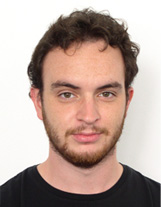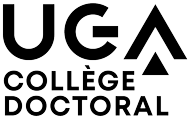2022 Academic Thesis Prize: Benoît ARRAGAIN
Headlines, Research
Benoît ARRAGAIN received the 2022 Academic Thesis Prize for his research work among PhDs graduating in 2021.
Thesis Title: Structural and functional analysis of Bunyavirales replication and transcription
 The Bunyavirales order encompasses over 500 species of segmented negative stranded RNA viruses (sNSV). Widespread throughout the world and considered as emerging viruses, the infection of humans by bunyaviruses can lead to serious diseases. In the Hantaviridae family, hemorrhagic fevers have been reported after Hantaan virus (HTNV) infection, while in the Peribunyaviridae family, La Crosse virus (LACV) infections have resulted in cases of encephalitis in children. In addition, the order Bunyavirales is related to other sNSVs such as influenza virus (Orthomyxoviridae), an infectious agent responsible for seasonal epidemics.The genomes of HTNV and LACV consist of three segments that encode four structural proteins: the glycoproteins (Gn and Gc), encoded on the M segment, the nucleoprotein (NP), encoded on the S segment and the polymerase, also known as L protein, encoded on the L segment. During infection, NPs protect the viral genome from damage and against innate immune response of the infected cell by multimerizing around the viral genome. These protein-RNA complexes form helical assemblies called nucleocapsids (NC). Both the 5' and 3' ends of each segment of the viral genome (vRNA) are respectively bound to an L protein. Interactions between L, NP and vRNA form a circularized complex called ribonucleoprotein (RNP). The RNPs present in the virus are the functional units that perform the replication and the transcription of each of the three viral segments.The replication of the vRNA first consists in the production of the complementary genome (cRNA) using vRNA as template, followed by the generation of new vRNA based on the cRNA template. The L protein, and in particular its RNA-dependent RNA polymerase (RdRp) region, plays an essential role in this reaction. During infection, the L protein also initiates the production of messenger RNAs that encode viral proteins. It first “steals” a 5' capped RNA segment from the infected cell via its cap-binding domain (CBD). This capped RNA is then cleaved by an endonuclease domain (ENDO) also present in the L protein, which ultimately initiates the synthesis of viral messenger RNA (mRNA) thanks to the RdRp catalytic domain: this is transcription.Currently, there is no treatment to counteract bunyavirus infections. It is therefore crucial to analyze the essential steps of their viral cycle described above in order to understand their mechanism of operation and potentially allow the development of new antiviral treatments.The overall objective of this thesis was to take advantage of cryo-electron microscopy to structurally and functionally characterize two major actors of replication and transcription in bunyaviruses, NPs and L proteins, using HTNV and LACV as models. I first determined the high-resolution structure of the recombinant HTNV nucleocapsid (HTNV-NC) to characterize the different interactions between the different NPs and understand the mechanism of encapsidation of the vRNA within the HTNV-NCs. Secondly, I determined the cryo-EM structures of both HTNV and LACV L proteins (respectively called HTNV-L and LACV-L) in complex with the 5' and 3' promoter regions. Finally, I performed the functional characterization of LACV-L via the implementation of in vitro activity assays. This enabled to stall LACV-L in several key stages of both replication and transcription, a pre-requisite that permitted the determination of seven high-resolution structures of LACV-L in action. The combination of these structural snapshots shows with unprecedented details the mechanisms underlying peribunyaviruses replication and transcription.
The Bunyavirales order encompasses over 500 species of segmented negative stranded RNA viruses (sNSV). Widespread throughout the world and considered as emerging viruses, the infection of humans by bunyaviruses can lead to serious diseases. In the Hantaviridae family, hemorrhagic fevers have been reported after Hantaan virus (HTNV) infection, while in the Peribunyaviridae family, La Crosse virus (LACV) infections have resulted in cases of encephalitis in children. In addition, the order Bunyavirales is related to other sNSVs such as influenza virus (Orthomyxoviridae), an infectious agent responsible for seasonal epidemics.The genomes of HTNV and LACV consist of three segments that encode four structural proteins: the glycoproteins (Gn and Gc), encoded on the M segment, the nucleoprotein (NP), encoded on the S segment and the polymerase, also known as L protein, encoded on the L segment. During infection, NPs protect the viral genome from damage and against innate immune response of the infected cell by multimerizing around the viral genome. These protein-RNA complexes form helical assemblies called nucleocapsids (NC). Both the 5' and 3' ends of each segment of the viral genome (vRNA) are respectively bound to an L protein. Interactions between L, NP and vRNA form a circularized complex called ribonucleoprotein (RNP). The RNPs present in the virus are the functional units that perform the replication and the transcription of each of the three viral segments.The replication of the vRNA first consists in the production of the complementary genome (cRNA) using vRNA as template, followed by the generation of new vRNA based on the cRNA template. The L protein, and in particular its RNA-dependent RNA polymerase (RdRp) region, plays an essential role in this reaction. During infection, the L protein also initiates the production of messenger RNAs that encode viral proteins. It first “steals” a 5' capped RNA segment from the infected cell via its cap-binding domain (CBD). This capped RNA is then cleaved by an endonuclease domain (ENDO) also present in the L protein, which ultimately initiates the synthesis of viral messenger RNA (mRNA) thanks to the RdRp catalytic domain: this is transcription.Currently, there is no treatment to counteract bunyavirus infections. It is therefore crucial to analyze the essential steps of their viral cycle described above in order to understand their mechanism of operation and potentially allow the development of new antiviral treatments.The overall objective of this thesis was to take advantage of cryo-electron microscopy to structurally and functionally characterize two major actors of replication and transcription in bunyaviruses, NPs and L proteins, using HTNV and LACV as models. I first determined the high-resolution structure of the recombinant HTNV nucleocapsid (HTNV-NC) to characterize the different interactions between the different NPs and understand the mechanism of encapsidation of the vRNA within the HTNV-NCs. Secondly, I determined the cryo-EM structures of both HTNV and LACV L proteins (respectively called HTNV-L and LACV-L) in complex with the 5' and 3' promoter regions. Finally, I performed the functional characterization of LACV-L via the implementation of in vitro activity assays. This enabled to stall LACV-L in several key stages of both replication and transcription, a pre-requisite that permitted the determination of seven high-resolution structures of LACV-L in action. The combination of these structural snapshots shows with unprecedented details the mechanisms underlying peribunyaviruses replication and transcription.Key Words: Virus, Cryo-electron microscopy, Nucleocapsid, Viral polymerase, Replication, Transcription
Doctoral School: ED CSV – Chimie et Sciences du vivant
Research Laboratory: Institut de Biologie Structurale (IBS – CEA/CNRS/UGA)
Thesis Supervision: Guy SCHOEHN and Hélène MALET
> To know all the 2022 thesis prizes
Updated on June 15, 2022

